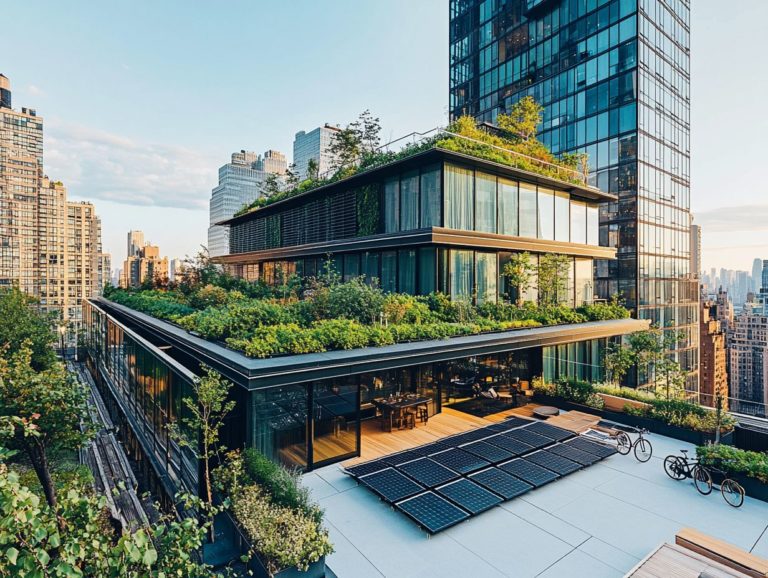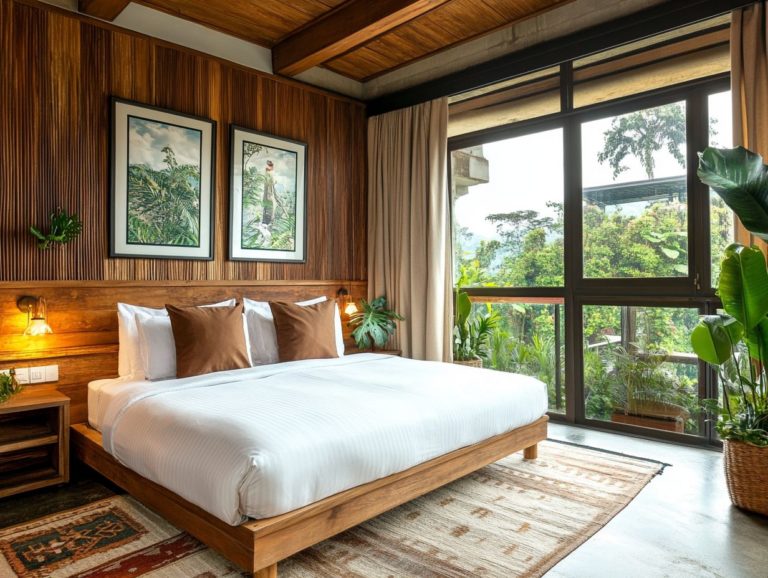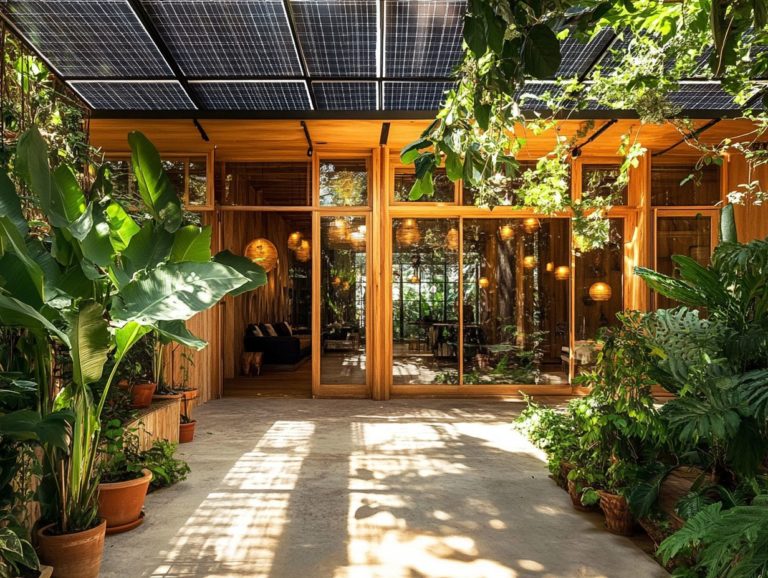Best Eco-Resorts for Romantic Getaways
Proper lighting can transform a space. It shapes your mood, productivity, and overall well-being.
This article explores the importance of adjusting light, especially the proper alignment of car headlights. It emphasizes the consequences of inadequate lighting and the essential factors to consider, such as room layout and types of artificial light used.
Discover practical tips for creating a balanced lighting plan tailored to your activities. Explore DIY projects for adjusting headlights and strategies suited for various environments, whether at home, in the office, or outdoors.
Identify common mistakes to avoid, like misaligned headlights. This ensures you achieve ideal illumination for any situation.
Contents
Key Takeaways:

- Proper light adjustment is crucial for creating a comfortable and functional space.
- Consider room layout, natural light, and types of artificial lighting when adjusting light.
- Creating a balanced lighting plan and adjusting light for various activities can improve the overall atmosphere of a space.
The Importance of Light Adjustment
Light adjustment plays a vital role in ensuring safety and visibility, especially for your car’s headlights. When misaligned, headlights can drastically reduce visibility at night, increasing the risk of collisions.
By aiming your headlights correctly, you improve your ability to see the road ahead and prevent blinding oncoming drivers. Every vehicle owner should realize how important it is to keep headlights properly adjusted, including understanding aiming specs and safety regulations.
In the automotive realm, ensuring accurate headlight adjustments enhances overall vehicle safety and elevates your driving experience.
Effects of Improper Lighting
Improper lighting from misaligned headlights can create serious visibility challenges at night, significantly raising the risk of collisions.
Driving with poorly aimed headlights makes it difficult to see pedestrians, cyclists, or obstacles in your path. This limited visibility distorts your perception of the distance to oncoming traffic, leaving little time to react in critical moments.
The glare from misaligned lights affects not just your view; it can also blind other drivers, turning the road into a perilous environment for everyone. Addressing these safety concerns through timely car repair, including checking headlight adjustments, improves your driving experience and promotes responsible vehicle maintenance.
Factors to Consider for Light Adjustment
When adjusting your headlights, consider a few key factors. Gas tank levels and tire pressure can significantly impact the effectiveness of the alignment.
Position your vehicle on flat ground. Use appropriate low-beam headlights, ensuring correct horizontal and vertical alignment. Techniques like vertical and horizontal tape lines, along with Honda bubble levels, will help you get it just right.
Room Layout and Natural Light
The layout of a room and its access to natural light can profoundly influence the quality of lighting, similar to how vehicle headlights impact visibility and ambiance on the road.
Imagine a well-organized room where windows and mirrors are strategically placed to enhance the flow of natural light, much like how properly aligned headlights improve road visibility. This thoughtful arrangement creates a warm and inviting atmosphere during the day, akin to how well-maintained vehicle headlights ensure safety at night.
It s similar to how adjustable headlights enhance nighttime visibility, allowing you to navigate dimly lit streets with ease, thereby avoiding collisions.
Regarding home maintenance and car maintenance, it s essential to optimize both the arrangement of your furniture and your lighting sources, including periodic headlight checks, to achieve the best possible illumination. By acknowledging the crucial role that natural light plays throughout the day, alongside light sources that create a soft background glow after sunset, you can cultivate spaces that are not only functional but also visually appealing.
Types of Artificial Lighting

Artificial lighting encompasses a variety of types, each carefully designed to enhance safety and visibility much like the critical importance of headlight alignment in the automotive industry.
Consider the different lighting options available: ambient, task, and accent lighting, which serve various purposes in both residential and automotive contexts. Ambient lighting creates a warm overall glow, while task lighting hones in on specific areas to assist with activities such as reading or cooking.
Automotive safety regulations outline the necessary specifications for headlights, including adjustment methods, ensuring maximum visibility during night drives or inclement weather. Just as a precisely aimed beam from a vehicle s headlights minimizes accident risks, effective artificial lighting guarantees that you can navigate your surroundings safely and comfortably, thus enhancing overall safety. This connection between lighting and automotive safety underscores the importance of thoughtful design in both realms.
Tips for Proper Light Adjustment
Achieving the right light adjustment demands meticulous planning and execution, making it an excellent DIY endeavor for car owners eager to elevate their vehicle’s safety and performance by adjusting their headlights.
By employing headlight adjusters, which are tools used to calibrate headlight angles, such as screw and socket wrench tools, and mastering the aiming process, you can ensure your headlights are precisely aligned. This is a vital step for safe night driving.
Creating a Balanced Lighting Plan
Creating a balanced lighting plan is crucial, not just for your home and office, but it also mirrors the importance of effectively aligning your headlights to ensure visibility at night and avoid collisions.
Just as properly aligned headlights light up the road ahead without dazzling oncoming drivers, a thoughtfully designed lighting arrangement elevates the atmosphere of any space while maintaining functionality and safety, much like good automotive design.
By assessing the specific needs of each area be it a cozy living room or a bustling workspace you can select the right type of lighting, whether it s ambient, task, or accent, paralleling how vehicle headlights serve different driving conditions.
Ensure that each fixture works in harmony to avoid harsh shadows or glaring spots, much like how every car owner should routinely check their headlights and ensure proper headlight alignment to prevent accidents. This meticulous attention to detail not only enhances the aesthetics but also fosters a comfortable environment where activities can unfold seamlessly.
Adjusting Light for Different Activities
Adjusting light for various activities is crucial for enhancing both productivity and comfort. Just like precise headlight alignment is vital for safety during night driving, the right levels of illumination are essential for your daily tasks.
For instance, when you re diving into detailed work like reading or writing, bright lighting is essential. Meanwhile, softer lighting can create a cozy atmosphere for leisure activities.
This concept also applies to how headlights need adjustments based on road conditions and weather, ensuring optimal visibility and safety. Different scenarios such as cooking, studying, or entertaining guests call for specific lighting tweaks, and understanding the best practices for light placement can help reduce strain.
Ultimately, understanding these dynamics empowers you to make informed choices regarding your lighting setups. This parallels the significance of properly aimed headlights for safe and efficient night driving. Additionally, adopting best practices for seasonal light adjustments can enhance your overall environment.
Light Adjustment for Different Environments
Light adjustment varies considerably across environments, whether in homes, offices, or outdoor settings. Recognizing these differences is essential for achieving optimal visibility at night.
Home, Office, and Outdoor Settings

In your home, office, and outdoor spaces, the type and arrangement of lighting play a pivotal role in enhancing visibility and setting the overall ambiance.
For example, opting for warm-toned lighting in your living areas fosters a cozy atmosphere. In contrast, cooler tones in workspaces can boost alertness and productivity.
Thoughtful lighting design is essential for safety. Path lights and porch illumination can effectively prevent accidents outdoors, just as using low-beam headlights correctly can prevent collisions on the road.
Regularly upgrading your light fixtures ensures they are energy-efficient and long-lasting. This not only improves visibility but also helps lower your utility bills.
By carefully selecting your lighting, you create an inviting environment that enhances functionality and enjoyment while reflecting your personal style.
Common Mistakes to Avoid
In lighting whether in vehicles or buildings you may encounter frequent mistakes, such as neglecting headlight checks. Such oversights can jeopardize safety and visibility.
Overlooking Lighting Needs
One common mistake is disregarding specific lighting needs, including the proper alignment of headlights. This can lead to inadequate visibility at night and increase the risk of collisions.
When you ignore the importance of proper headlight alignment, you create blind spots and struggle to see obstacles or road markings clearly. This heightened risk affects not just you, but pedestrians and other vehicles as well.
Consistent maintenance of your lighting systems is essential. It allows you to respond swiftly to unexpected situations, reducing the likelihood of accidents caused by poor visibility.
As a responsible vehicle owner, prioritize regular headlight checks to uphold safety standards on the roads. Check your lighting today to make your spaces safer and more inviting!
Are You Risking Safety with Poor Lighting?
Using inappropriate lighting, whether in vehicles or other settings, can significantly compromise safety and visibility. Proper headlight alignment is crucial for safety.
When you rely on headlights that are dim, misaligned, or simply inadequate for road conditions, you’re not just putting yourself at risk; you’re also endangering everyone else on the road.
Effective lighting is crucial for safety, helping to illuminate potential hazards and enabling timely reactions to obstacles and shifts in traffic.
The importance of maintaining proper headlight use cannot be overstated. It directly impacts your ability to navigate safely in low-light conditions.
This shows how your lighting choices matter whether in your vehicle or home, where poor illumination can lead to accidents and injuries.
Frequently Asked Questions
-
What are some best practices for light adjustment?

1. Avoid harsh, direct light: When adjusting the lighting in a space, it’s important to avoid using bright, direct light sources. This can create harsh shadows and cause discomfort for those in the room.
-
How can I achieve balanced lighting?
Using a combination of natural and artificial light sources is the best way to achieve balanced lighting. This will help create a more natural and comfortable environment.
-
What is the recommended brightness level for different areas?
3. Follow the 3:1 rule: It’s recommended to have three times more ambient light than task lighting in any area. This helps reduce eye strain and creates a more comfortable atmosphere.
-
How often should I adjust the lighting in a space?
4. Consider the time of day: Adjust the lighting in a space according to the time of day. As natural light changes, so should your artificial lighting to maintain a comfortable and productive environment.
-
What are some common mistakes to avoid when adjusting lighting?
5. Avoid using only overhead lighting: Relying solely on overhead lighting can create unevenness and shadows. Incorporate multiple light sources for balanced lighting.
-
How can I reduce glare in a space?
6. Use indirect lighting: To reduce glare, consider using indirect lighting sources such as wall sconces or floor lamps. This creates a softer and more diffused light, making it easier on the eyes.
Check your lighting and make necessary adjustments for better safety!






